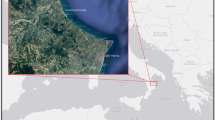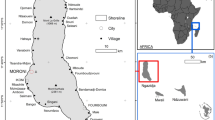Abstract
Offshore tracts in Alaska's lower Cook Inlet are scheduled to be opened for exploratory petroleum drilling in the near future. Because of the potential for oil spills resulting from this activity, a field study of the coastal zone was conducted in June 1976. A total of 1216 km of shoreline was classified into 3 types: erosional (45 percent), neutral (38 percent), and depositional (17 percent). These were further subdivided into 16 subclasses on the basis of small scale morphological features. This classification was used in conjunction with a vulnerability index of potential oil spill damage, developed through study of three major oil spills, to predict the longevity of oil in the different coastal environments of the Inlet. On a scale from 1 to 10, 45 percent of the shoreline has low values of 1 to 4, which means that oil would be dispersed by natural processes within less than six months after a spill on these coasts. Values from 4 to 6 were assigned to 13.4 percent of the shoreline, where oil residence time may be up to one year. A 6 to 10 rating was assigned to 41.5 percent of the shoreline, where oil contamination may remain for periods of two to ten years, or possibly longer should no major clean-up procedures be initiated. We propose that the use of this type of vulnerability indexing, in conjunction with a biological susceptibility index and oil spill trajectory models, would provide a rational basis for decision making concerning the location of on- and off-shore oil facilities and the design of oil spill contingency plans.
Similar content being viewed by others
References Cited
Duerden, F. C., 1975, Spill in Portugal, a report of theJakob Maersk incident: Environment Impact and Assessment Report EPS-8-EC-76-1, Environment Protection Service, Canada, 32 p.
Gundlach, E. R., I. A. Fischer, and R. J. Stein, 1977, The black tide of La Coruña: oil spill off Spain: Oceans, v. 10, no. 2, p. 56–63.
——, and M. O. Hayes, 1977, TheUrquiola oil spill, La Coruña, Spain: case history and discussion of methods of control and clean-up: Marine Pollution Bulletin, v. 8, no. 6, p. 132–136.
Hayes, M. O., E. H. Owens, D. K. Hubbard, and R. W. Abele, 1973, Investigations of form and processes in the coastal zone,in Coates, D. R., ed., Coastal geomorphology: Proc. 3rd Annual Geomorphology Symposia Series, Binghamton, N.Y., p. 11–41.
——, and E. R. Gundlach, 1975, Coastal geomorphology and sedimentation of theMetula oil spill site in the Strait of Magellan: Report to Advanced Environmental Research and Technology, National Science Foundation, Coastal Research Division, Univ. South Carolina, Columbia, S.C., 103 p.
——, P. J. Brown, and J. Michel, 1976a, Coastal morphology and sedimentation, lower Cook Inlet, Alaska, with emphasis on potential oil spill impacts: Tech. Rept. No. 12-CRD, Coastal Research Division, Univ. South Carolina, Columbia, S.C., 107 p.
--, E. R. Gundlach, and R. M. Perhac, 1976b, The great Papagonian oil spill: (abs.)in Proc. AAPG-SEPM Meeting, May, New Orleans, La. p.
Author information
Authors and Affiliations
Rights and permissions
About this article
Cite this article
Michel, J., Hayes, M.O. & Brown, P.J. Application of an oil spill vulnerability index to the shoreline of lower Cook Inlet, Alaska. Geo 2, 107–117 (1978). https://doi.org/10.1007/BF02380473
Issue Date:
DOI: https://doi.org/10.1007/BF02380473




